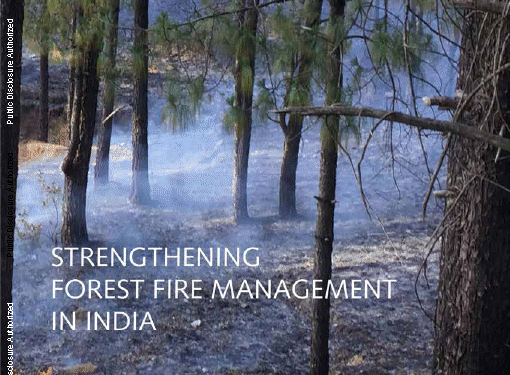NEW DELHI, October 09, 2018 – At a time when India has managed to increase its forest cover to over 20 percent of its geographical area, forest health continues to show signs of strain. Regeneration is either inadequate or absent in about 45 percent of all forest areas and about 95 percent of all forest plots inventoried show some signs of degradation.
The report, “Strengthening Forest Fire Management in India”, jointly prepared by the Ministry of Environment, Forest, and Climate Change (MoEFCC) and the World Bank says forest fires are today a leading cause of forest degradation in India. The report discusses policies on forest fire prevention and management (FFPM) at the national, state and local levels, underscoring the need for a comprehensive national policy and guidelines. It provides recommendations on five broad themes – policy, institutions and capacity, community engagement, technology, and data and information and looks at national and international best practices in FFPM.
According to the Fifth Assessment Report of the Intergovernmental Panel on Climate Change, the annual carbon emissions from forest fires globally range between 2.5 billion to 4.0 billion tons of CO2, adding large volumes of greenhouse gases to the atmosphere.
The report was released by Dr Harsh Vardhan, Hon. Minister of Environment, Forest, and Climate Change at an event today. Speaking at the event Dr Vardhan said: “Forest fire management is part of our long-term vision for sustainable forest management. It is also crucial for sustaining progress towards our global pledge of creating additional sinks of 2.5 billion to 3 billion tons worth of CO2 stored in its forests by 2030.”
“The new study will provide critical inputs for the preparation of Government of India’s National Action Plan on Forest Fire Prevention and Management,” he added.
The report analyses patterns and trends of forest fires in India. While the findings of this study indicate that forest fires occur every year in almost every state in India, some districts have been found to be more vulnerable than others. In fact, just 20 districts (mostly located in the Northeast) account for over 40 percent of all forest fires detected between 2003 and 2016. Similarly, the top-20 districts (mainly in Central India) account for about 48 percent of the total fire-affected area, while having just 12 percent of the country’s forest cover in the year 2000 and 7 percent of its land area.
“Forest fires are a challenge across many countries. They lead to the loss of lives and livelihoods for people directly dependent on forest produce. This report discusses policies on forest fire prevention and management and underscores the need for better fire prevention practices and a well-equipped and trained workforce to fight fires,” said Junaid Ahmad, World Bank Country Director in India. “We are delighted to have this opportunity to work with the MoEFCC on this important agenda, and to contribute towards informing its National Action Plan on Forest Fire Prevention and Management in India.”
Good management is built on good knowledge
Today many states in India are trying out innovative solutions for fire prevention and management. Using satellite data, Madhya Pradesh was the first state to develop an SMS-based system to alert field staff about active forest fires in their area. Odisha has pioneered the use of fire suppression equipment and states like Mizoram, Tripura and Madhya Pradesh have effectively involved the community in preventing forest fires. States can learn from each other’s experiences to make these systems more effective, the report suggests. “We recommend that a formal mechanism for knowledge sharing between states should be established so that states can learn from each other,” note Urvashi Narain, Lead Economist, and Pyush Dogra, Senior Environmental Specialist, World Bank, and lead authors of the report.
Investing to make service delivery more effective
While India has made great strides in the use of technology for detecting forest fires, there is still a need to strengthen fire prevention practices and to build a well-equipped and trained workforce to fight fires. Investments in modern technologies for fire detection, investing in adequate fire suppression and safety equipment, while at the same time working to build capacity across the rank of forest officers and improving accountability will help the forest department deliver on this mandate, the report says. Rather than prescribing specific fire-suppression tools to be used in all states, states be encouraged to experiment, and best practices be scaled up, where appropriate. There is also an urgent need to fill vacancies for field staff, particularly in fire-prone areas, and to make adequate and reliable funding available, the report adds.
Partnering with communities and disaster management agencies
Recognizing the fact that people will continue to use forest fire, and that some fire is desirable, engaging with the communities that depend on forests and involving them in the decision-making process is therefore vital, as is improving coordination with the other agencies that are involved in managing forests and responding to forest fires, such as disaster management agencies, the report says. It also suggests that the National FFPM Action Plan should delineate the roles and responsibilities of the MoEFCC, state forest departments, communities, and disaster agencies.
Improving data and research
Lastly, there is a need to support forest fire management through improved data, and research to fill critical knowledge gaps. A national forest fire information database, bringing together satellite-based remote sensing data, and field-reported data, will be instrumental for assessing longer-term trends across states and regions and for planning fire prevention and response. Also, defining a national research agenda for fire management and provision of funding opportunities for scientific research would help to establish formal cooperation between members of the research community and the forest department.













































